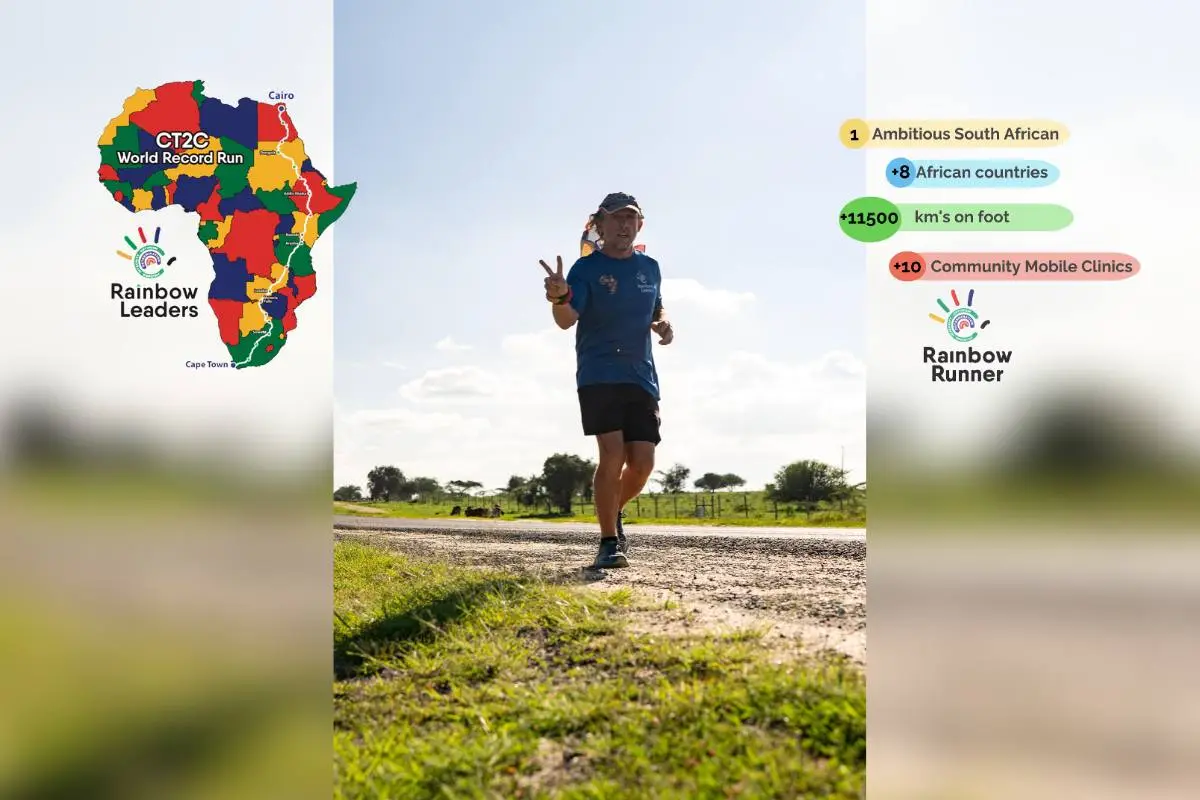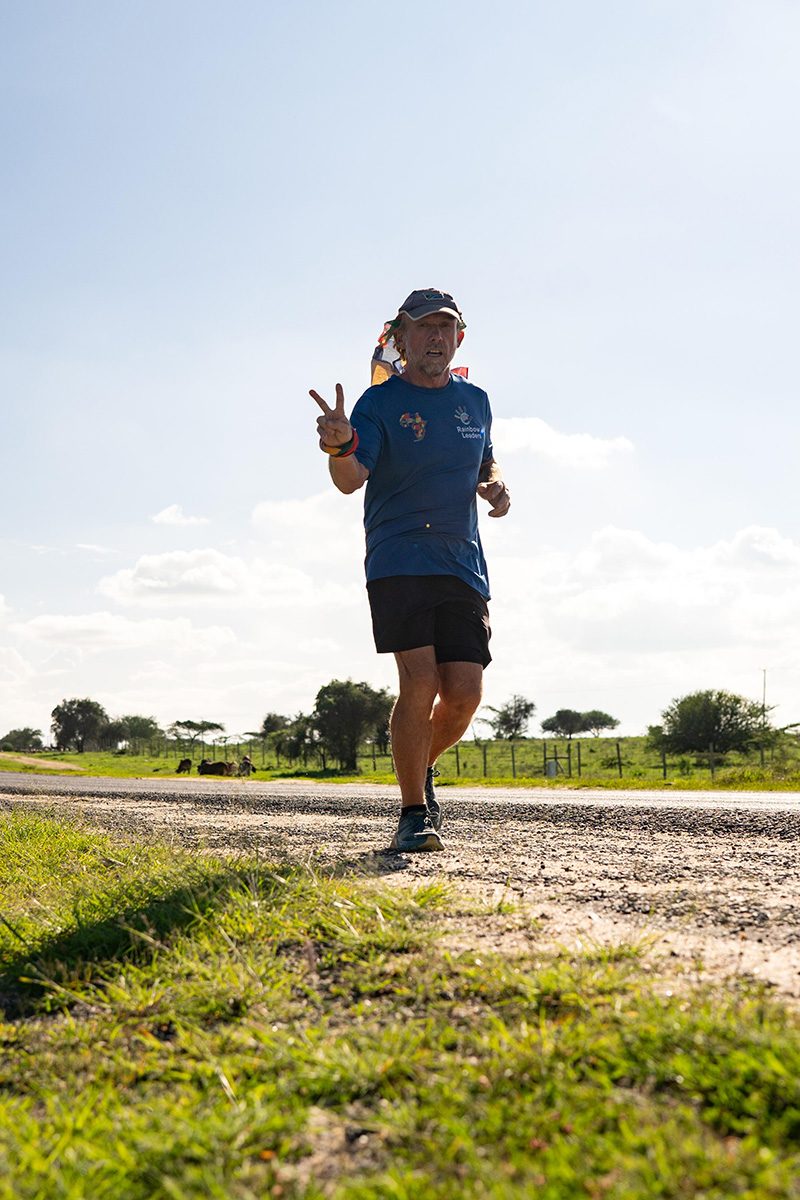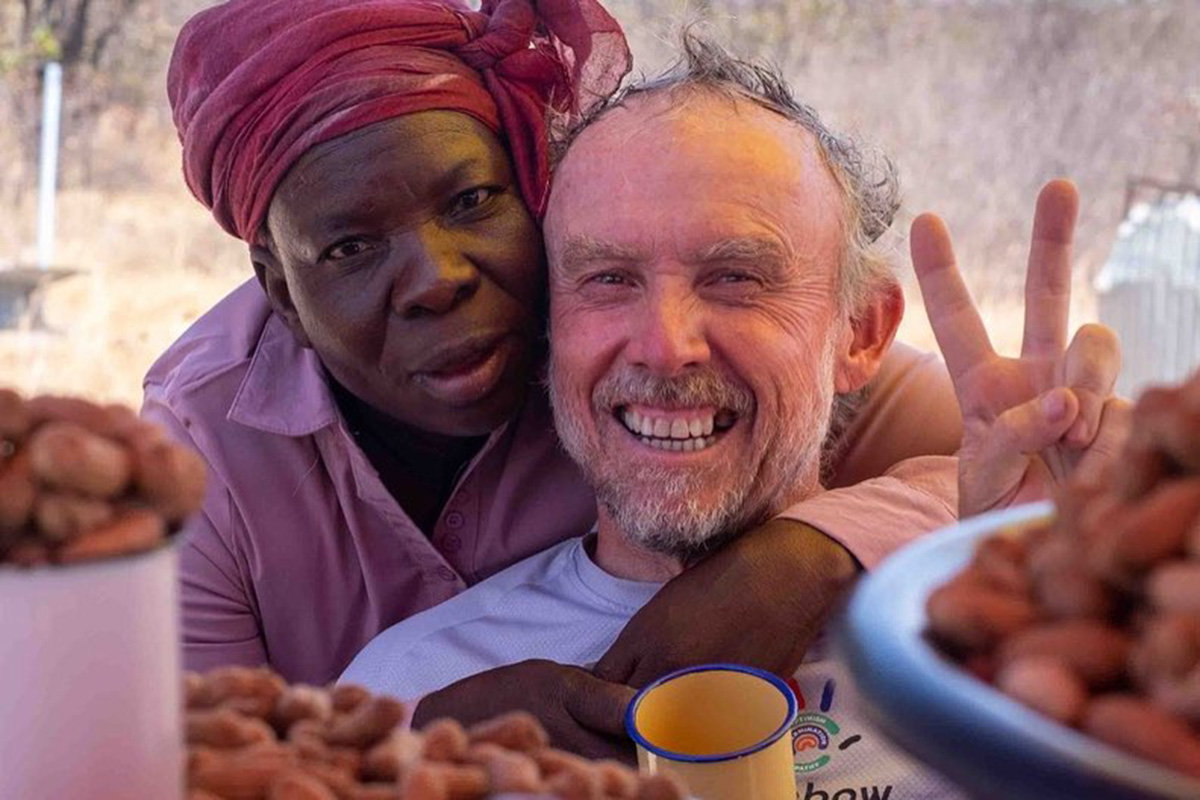

Keith Boyd is on a mission to run from one tip of the African continent to another in an extraordinary feat of human endurance and determination. From Cape Town, South Africa to Cairo, Egypt, Boyd is hoping to break the world record time for this feat—318 days. This record, set in 1998, is held by Nicholas Bourne, who covered over 12,069 km (7,500 miles) through Botswana, Zambia, Tanzania, Kenya, Ethiopia, and Sudan.
Videos by Outdoors
Boyd’s initial goal was to reach Cairo in 280 days, but at his current run rate of more than 40 km (25 miles) a day, he’s running a marathon distance every single day, and it’s looking like he might manage to do it in 260 days. If he keeps pace, he’ll certainly break the 25-year-old world record.
Boyd, affectionately known as the Rainbow Runner, is putting in the long mileage for more than just the chance to break a record. The 57-year-old retired telecoms entrepreneur, who holds dual British and South African citizenship, was born in Scotland but moved to South Africa when he was four. In 2017, he founded a charity called Rainbow Leaders, an independent, nonpolitical NGO encouraging young South Africans to register to vote, and it’s in this charity’s name that he’s running the length of Africa.
The Rainbow Runner began his quest in Cape Town in July 2023, and the plan is still to reach Cairo in April 2024. 11,500 km (7,150 miles) is a long way to go to inspire people, but Boyd strongly believes that empowering youth to vote is a powerful catalyst for change and growth. Ultimately, Boyd hopes to raise $2.7 million or more for Rainbow Leaders during his cross-continent run.
An Epic Undertaking
How does one prepare for such an epic undertaking? Boyd admits the physical toll his journey has been taking on his body lately has been “brutal.”
In January 2023, Boyd, who has previously run Ironmans, marathons, and ultra-marathons, got into serious training mode, increasing his monthly distances from 20 km (12.5 miles) to over 800 km (500 miles). He has a genetically inherited heart condition, which increases the risk of heart disease, but Boyd says he’s more concerned about his joints than his heart.
Thankfully, Boyd says his legs are still “pulling their weight.” Even the right knee, which had posed challenges during training, is holding up. His left ankle has been problematic, but he’s adapted by changing shoes throughout the day, altering the foot strike to effectively manage the issue.
The Rainbow Runner aims to consume around 5,000 calories a day, where possible focusing on smoothies, protein shakes, fruit and nuts, and vegetable and chicken soups, so as not to overload his digestive system.
As he runs, Boyd says he manages to get into a “moving meditative state,” helped by his playlist, which includes such artists as Tracy Chapman, Ladysmith Black Mambazo, and Jeremy Loops. For some moral support, his wife and three children join him for various legs of the journey.
“[This] attempt will require me to run more than a marathon a day, without rest days, for approximately nine months,” Boyd says, and it’s all in the name of charity. The Rainbow Runner’s journey is living proof that change starts by putting one foot in front of the other, both literally and metaphorically.
We interviewed Boyd about what it’s like being on his incredible journey.
Q&A with the Rainbow Runner

Outdoors.com: How do you prepare both mentally and physically for such an extensive and challenging run through such diverse terrains?
Boyd: I am African and have spent more than 50 years living, working, and doing business throughout the continent, giving me a better-than-average understanding of the many and diverse peoples and countries, their different languages, traditions, and idiosyncrasies. In effect, I’ve spent more than 50 years preparing for this journey. And then in terms of the heat; growing up in a warm climate, I love the heat, and moving in it is much more pleasant for me than moving in the cold. Though, with the heat can come heat exhaustion and heat stroke—so, hydration is the most important thing you have to get right.
And then physically . . . I had a heart procedure in April, as I have a familial cardiac condition, and that dented my training for a month. We’d initially planned to start in Cairo in September but decided to start in Cape Town, because of its better medical infrastructure. This meant moving the start date forward by two months to beat the heat in the Sahara, so I was totally underprepared. As a consequence, I suffered quite a lot in the first three months of the expedition.
Outdoors.com: What are some of the most memorable moments or challenges you’ve encountered so far on this epic run?
Boyd: You know the comment ‘pride comes before a fall’? Well, I think I’d run 3,500 km (2,175 miles) without a fall, and then one day [I] took a tumble and cut my hand on some broken glass, and then only two weeks later, I fell again—twice in one day. I’d stumbled lots, but had always managed to save myself, and then just as I was thinking I might make it to Cairo without falling over, I took my first tumble.
The hospitality in Zambia was outstanding. The whole team was treated so magnificently, put up in the most fantastic accommodations, etc., so that was definitely a highlight.
Outdoors.com: How do you maintain a balance between pushing your physical limits and ensuring your overall well-being during the journey?
Boyd: I’ve got a great team around me, and while we’ve had some upsets and disappointments in the team, with some people not being up to the job, on the whole, I think it’s about family, it’s about friends, it’s about the core team holding things together.
Outdoors.com: As the “Rainbow Runner,” how do you connect with local communities along the route, and have any cultural interactions or experiences stood out to you?
Boyd: It’s fantastic when I have an interpreter with me and can engage with the local people and have some wonderful conversations. [. . .] I’ve had numerous meaningful exchanges along the way.
I’d like to come back in a year’s time and see some of the people we’ve met and had conversations with and see how they’ve progressed.
Outdoors.com: What kind of gear and equipment are essential for a run of this magnitude, and how do you manage logistics throughout the journey?

Boyd: I’d probably start with shoes . . . I have a bit of a wonky left ankle and a niggly right knee, and that combination means that the right knee prefers to have a soft-soled shoe with lots of cushioning . . . and then my left foot needs something that stabilizes my left ankle and prevents it from rolling in. So I alternate shoes and have even been known to run with a stability shoe on my left foot and a soft-cushioned shoe on my right.
Shoes are the most important piece of equipment, but after that then sunscreen and a good hat, preferably one of those peaked hats with an ‘Arabian-style’ cloth attachment at the back which blows out behind you, creating shade on the back of your neck while allowing the wind to circulate and reduce heat.
Shoes, sunscreen, and a good hat. Aside from that, just got to go with what works for you.
My advice would be to aim for something big and just go for it. If you fall or fail, failure is a great thing, because you learn so much.
Keith Boyd
Outdoors.com: Can you share some tips for aspiring long-distance runners or adventurers who might be inspired by your remarkable journey?
Boyd: My advice would be to aim for something big and just go for it. If you fall or fail, failure is a great thing, because you learn so much. That’s what I’ve found out so often in my life, and that’s also why embarking on this journey didn’t scare me.
I thought, ‘Well, I’ve got a 90% chance of failing. But let’s go and try.’ I think people, not just endurance athletes, but from all walks of life, think, ‘If I’ve only got a 10% chance or a 50% chance of succeeding, then I won’t do it.’ But I think one has to realize that you’ll never be completely ready for a challenge. So, do a reasonable amount of preparation and then say to yourself ‘Just go for it.’ Keep your wits about you, practice within your capabilities, and just go for it, and recognize that failure is part of making you a successful person in your life as an athlete, or in any other facet of your life.
Outdoors.com: How do you adapt your running to different climates and terrains as you progress from Cape Town to Cairo?


Boyd: In hotter climates, I’ll be up just after four o’clock, five, if I can, and then I’ll take three or four hours off in the middle of the day. From 12 o’clock to 4 o’clock, I might or might not move, or I might just walk slowly. In intermediate kind of heat . . . I might walk or jog more slowly, and I certainly take more isotonic and electrolyte drinks, as my body craves that. In terms of running on-road or off-road, there needs to be mindfulness in changing your footwear to suit the surface and conditions.
Outdoors.com: Throughout the Rainbow Run, have you faced any unexpected or surprising encounters with wildlife (or unwanted people), and how do you handle such situations?
Boyd: The scariest has been lions. We’d recced the route—a small, seldom used, off-road hunting track, the evening before, just to make sure it didn’t contain any impossible river crossings, etc.—[but] the next morning, we found lion prints on top of our tire tracks. I kept very close to the vehicle on my run that day, and kept the tailgate down so that I could jump in quickly if necessary.
I do love to run with the local children. Some of them have probably never seen a white person in the flesh before, and some of them are scared and run away when they first see me, but then when I smile and wave, they’ll smile back. There’s nothing better than those brilliant encounters.
On the downside, there are occasionally drunk men who call out and harass me and won’t take no for an answer or go away when I ask them to.
Outdoors.com: The journey spans various countries with different political and social landscapes. How do you navigate any challenges related to border crossings or cultural differences?
Boyd: It’s understanding that humans are essentially all the same—human beings. Sometimes you just need to show respect, be friendly, and put your arm around them and have a chat, instead of being intimidated. I haven’t had any problems we haven’t been able to overcome so far.

Outdoors.com: How do you stay connected with your support team and followers during the run, and how has social media played a role in documenting your adventure?
Boyd: Social media has been a blessing and a curse. It’s forced me to write thousands and thousands of words for my Instagram posts over the last five months. I didn’t used to be on social media until a month or two before this trip. It’s important for us to stay connected to our followers to raise awareness of the cause and help us raise funds for our voter motivation and education programs.
Outdoors.com: Nutrition is crucial for such a physically demanding journey. What dietary strategies do you employ to maintain your energy levels?
Boyd: It’s been tough at times. At times, fresh fruit and vegetables have been in very short supply in the last week or so week, and so has protein. I’ve had to increase my uptake of protein supplements. The idea is to take 100-150 grams of protein a day, and I’m probably falling short of that a little bit at the moment. My weight is pretty stabilized now at about the 70 kg (154 lbs) mark, which is about 10 kg (22 lbs) lighter than when I started. On the whole, I’m happy that my diet is working.
Outdoors.com: Have you had the chance to interact with local runners or athletes in the regions you pass through, and what has that experience been like?
Boyd: I had people join me on certain stretches in South Africa. And other people have joined me in the big towns along the way. It’s lovely running with other runners. My son ran with me for eight days in Tanzania in southern Kenya, and that was an enormous help. Yesterday, I ran with a bundle of kids here in Ethiopia. They couldn’t understand me, and I couldn’t understand them, but we had a really good run together, and they were really good pacemakers.
I think sometimes people imagine that I run for five hours flat out each day. But that isn’t how you do these things. You don’t run flat out for five hours a day. You may run for two or three hours a day and then walk or slow jog. And then there are days that you have to walk the whole day because you’re having problems with your joints or something. But I try to make sure that when the runners do join me, I’m in running mode, and we enjoy ourselves.

Outdoors.com: How do you manage the psychological aspects of such a long and challenging run, and are there mental strategies you rely on to stay focused and motivated?
Boyd: Five months into this journey, I’ve got just less than three months to go. I try to break the journey up into bite-sized chunks. I think about what’s the next city, what am I going to see there, what am I going to have to eat there, what type of accommodation will I have, and what little luxuries can I look forward to when I get there. And of course, if it’s family or friends coming to meet me, then that gives me something to look forward to.
Outdoors.com: You’re doubtless inspiring others to pursue their own adventures, what advice would you have for individuals who are considering embarking on a similar long-distance journey?
Boyd: Do it!









